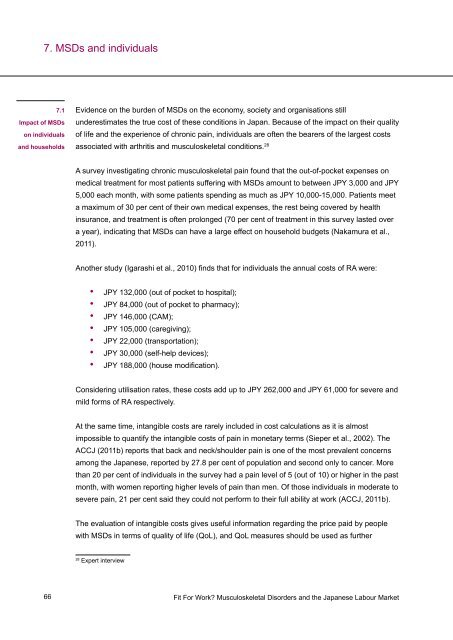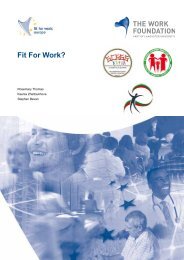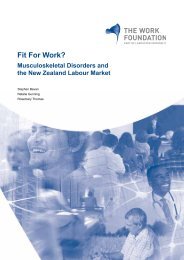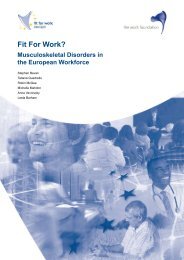English version - Fit for Work Europe
English version - Fit for Work Europe
English version - Fit for Work Europe
Create successful ePaper yourself
Turn your PDF publications into a flip-book with our unique Google optimized e-Paper software.
7. MSDs and individuals<br />
66<br />
7.1<br />
Impact of MSDs<br />
on individuals<br />
and households<br />
Evidence on the burden of MSDs on the economy, society and organisations still<br />
underestimates the true cost of these conditions in Japan. Because of the impact on their quality<br />
of life and the experience of chronic pain, individuals are often the bearers of the largest costs<br />
associated with arthritis and musculoskeletal conditions. 28<br />
A survey investigating chronic musculoskeletal pain found that the out-of-pocket expenses on<br />
medical treatment <strong>for</strong> most patients suffering with MSDs amount to between JPY 3,000 and JPY<br />
5,000 each month, with some patients spending as much as JPY 10,000-15,000. Patients meet<br />
a maximum of 30 per cent of their own medical expenses, the rest being covered by health<br />
insurance, and treatment is often prolonged (70 per cent of treatment in this survey lasted over<br />
a year), indicating that MSDs can have a large effect on household budgets (Nakamura et al.,<br />
2011).<br />
Another study (Igarashi et al., 2010) finds that <strong>for</strong> individuals the annual costs of RA were:<br />
• JPY 132,000 (out of pocket to hospital);<br />
• JPY 84,000 (out of pocket to pharmacy);<br />
• JPY 146,000 (CAM);<br />
• JPY 105,000 (caregiving);<br />
• JPY 22,000 (transportation);<br />
• JPY 30,000 (self-help devices);<br />
• JPY 188,000 (house modification).<br />
Considering utilisation rates, these costs add up to JPY 262,000 and JPY 61,000 <strong>for</strong> severe and<br />
mild <strong>for</strong>ms of RA respectively.<br />
At the same time, intangible costs are rarely included in cost calculations as it is almost<br />
impossible to quantify the intangible costs of pain in monetary terms (Sieper et al., 2002). The<br />
ACCJ (2011b) reports that back and neck/shoulder pain is one of the most prevalent concerns<br />
among the Japanese, reported by 27.8 per cent of population and second only to cancer. More<br />
than 20 per cent of individuals in the survey had a pain level of 5 (out of 10) or higher in the past<br />
month, with women reporting higher levels of pain than men. Of those individuals in moderate to<br />
severe pain, 21 per cent said they could not per<strong>for</strong>m to their full ability at work (ACCJ, 2011b).<br />
The evaluation of intangible costs gives useful in<strong>for</strong>mation regarding the price paid by people<br />
with MSDs in terms of quality of life (QoL), and QoL measures should be used as further<br />
28 Expert interview<br />
<strong>Fit</strong> For <strong>Work</strong>? Musculoskeletal Disorders and the Japanese Labour Market







